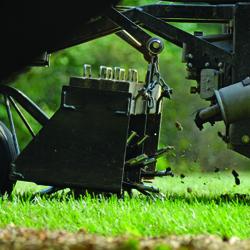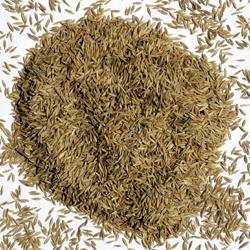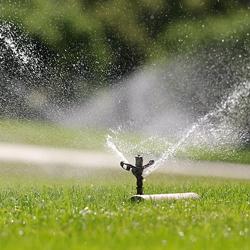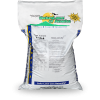Benefits of Core Aeration, Seeding, and Fertilizing Your Lawn
Introduction to Lawn Aeration
Understanding how to aerate your lawn begins with grasping the what and the why.
Lawn aeration is a crucial process that allows your yard to breathe, ensuring it remains healthy and vibrant. Aerating your lawn involves making small holes in the soil, allowing water, nutrients, and air to penetrate the grass roots. The holes help roots grow deeply, producing a more robust and resilient lawn.
The entire lawn aeration process contributes significantly to your lawn's overall vitality and longevity, giving it the essential care it needs to flourish throughout the year. It’s a beneficial and critical practice for maintaining the lushness and health of your lawn.
Why Aerate Your Lawn?
Aerating isn't just a task for the green-thumbed among us; it’s essential for anyone aiming to maintain a lush and healthy lawn.
The procedure helps to break down thatch, a layer of dead grass and roots that can build up on your lawn's surface. Thatch can prevent essential elements like water and nutrients from reaching the soil, leading to a less robust lawn.
When you aerate your lawn, you combat thatch buildup and promote the flow of vital nutrients, water, and air to the grassroots. This process supports the growth of a healthier, stronger, and more resilient turf, ensuring your lawn remains a beautiful and enjoyable outdoor space.
When to Aerate Lawn: Timing is Everything
Knowing the right time to aerate is vital for maximizing the benefits of aeration.
The best times to aerate lawns are during spring and fall growing seasons. This timing allows the grass to heal and fill open areas after removing soil plugs. For cool-season grasses, opt for fall aeration when the grass is breaking dormancy and experiencing a growth spurt. Spring is the prime time for aerating lawns for warm-season grasses, as it's the period of rapid growth for these grass types.
Ensuring you aerate at the right time maximizes the efficacy of the process, leading to a healthier and more vibrant lawn throughout the year.
How to Aerate Your Lawn: A Step-by-Step Guide
Aerating a lawn might seem daunting, but with the proper steps, it's a breeze.
Here’s how to aerate your lawn effectively:
- Prepare Your Lawn: Water your lawn thoroughly one or two days before aerating it as it softens the soil, allowing the aerator to penetrate deeper and remove soil cores more efficiently.
- Select the Right Aerator: Use a plug aerator to remove plugs of soil from the lawn. Avoid spike aerators as they can further compact the soil.
- Aerate the Lawn: Run the aerator over the lawn in a pattern that covers the area thoroughly, similar to mowing. Make multiple passes over areas that need extra attention.
- Clean Up: Leave the soil plugs on the lawn to decompose. They will return essential nutrients to the soil as they break down.
- Water Again: Water the lawn after aeration to encourage the grass roots to delve deeper into the soil.
Follow these steps for an efficient, adequate aeration that will leave your lawn looking lush and healthy.
Overseeding: A Vital Step Post Aeration
After aerating, it’s time to talk about how to seed a lawn.
Overseeding spreads grass seeds over the aerated lawn to encourage new grass growth. This practice helps fill any thin or bare spots, ensuring your lawn is thick, lush, and robust.
To be overseeded effectively, choose a high-quality grass seed that suits your lawn type and climate. Spread the seeds evenly across the lawn, ensuring good seed-to-soil contact for optimal germination. Water the overseeded area consistently to keep the soil moist, aiding the sources in germination and growth.
This simple yet crucial step helps to enhance your lawn's overall health and appearance, making it more resilient and vibrant.
Proper Lawn Fertilization: How to Correctly Feed a Lawn
Upon completing the aeration and overseeding, it’s crucial to understand how to nourish your newly revitalized lawn properly. Fertilizing plays a vital role in maintaining the health and beauty of your turf.
Select a lawn fertilizer rich in nutrients and suited to your specific type of grass.
Spread the fertilizer evenly across your lawn to ensure each area receives the necessary nutrients for growth and development. It’s best to fertilize right after aerating and seeding, allowing the fertilizer to sink into the aeration holes ensuring deeper soil penetration.
Proper fertilization encourages a lush, green, healthy lawn that stands out and offers a beautiful outdoor space for relaxation and play.
Gear Up for Aeration and Seeding with Essential Equipment
Getting your hands on the right equipment is fundamental for a smooth and successful aeration and seeding process.
Reserve an aerator well in advance to ensure availability. Opt for a core aerator that removes soil plugs for more effective aeration.
For spreading seeds and fertilizer, a broadcast or drop spreader works efficiently. Ensure you have quality grass seed and lawn fertilizer on hand on the day of aeration.
Additionally, wear appropriate safety gear to prevent any accidents during the process. Proper equipment makes the task more manageable and ensures a well-done job, promoting a thriving and vibrant lawn.
Post-Aeration, Seeding, and Fertilization Care
After aerating, seeding, and fertilizing, your lawn requires meticulous care to ensure robust growth and development.
Consistent and adequate lawn watering is pivotal in the first few weeks post-aeration and overseeding. This moisture aids in the seamless germination of new seeds and helps the fertilizer to penetrate the soil thoroughly, providing essential nutrients to the grass roots.
Clear the lawn of debris to prevent any hindrance to new grass growth. Be patient and allow the grass to grow, avoiding mowing your lawn until the new grass is at least 3 inches tall. Diligently following these post-care steps ensures your efforts in lawn aeration, seeding, and fertilization culminate in a lush and hearty yard.
Concluding Thoughts and Your Path Forward with Lawn Aeration
In closing, the steps to successful lawn aeration, seeding, and fertilization, though detailed, pave the way to a flourishing and resilient lawn. Patience and adherence to the outlined procedures ensure your lawn receives the essential care it craves, reflecting your effort in its lush, green expanse.
Should you seek further assistance or helpful products for aerating, seeding, and fertilizing your lawn, do not hesitate to contact us at Natural Alternative. Our dedicated team is always ready to assist you in achieving the lawn of your dreams.
For a comprehensive Lawn Aeration & Seeding Service near you, explore our sister company, NaturaLawn of America, to request a free local lawn care quote today!
Lawn Aeration, Seeding & Fertilization FAQs
How does core aeration benefit my lawn?
Core aeration significantly enhances your lawn’s health by creating small holes in the soil. This process allows more accessible water, air, and nutrients, making a more vigorous, vibrant turf. As the soil plugs decompose, they release beneficial nutrients back into the lawn, helping to control thatch buildup.
Why is overseeding important post-aeration?
Overseeding is crucial as it spreads new grass seed over your aerated lawn, filling any thin or bare spots. This practice ensures your lawn is thick, lush, and robust, enhancing its overall health and appearance.
When should I fertilize my lawn post aeration and seeding?
Fertilize your lawn right after aerating and seeding. This timing allows the fertilizer to sink deep into the aeration holes, ensuring your lawn receives essential nutrients for optimal growth and development.
What equipment is necessary for aeration and seeding?
Reserve a core aerator and a broadcast or drop spreader for seeds and fertilizer. Ensure you have quality grass seed and fertilizer on hand on the day of aeration and wear appropriate safety gear.
What post-care is necessary for my lawn?
Post aeration, seeding, and fertilization ensure consistent and adequate watering, clear the yard of debris, and avoid mowing until the new grass is at least 3 inches tall.
Contact us at Natural Alternative for more questions or assistance regarding your lawn care journey.
What is the best time to aerate and seed my lawn?
The optimal lawn aeration and seeding time varies based on your grass type. Generally, fall is best for cool-season grasses, while spring is ideal for warm-season grasses. Correct timing is essential for the most effective aeration and overseeding results.
How long should I wait before mowing my newly aerated and seeded lawn?
Wait until your new grass reaches at least 3 inches in height before mowing. This pause allows the new seeds ample time to germinate and establish strong roots, ensuring a healthy, thick lawn in the long term.
Now that I know how to aerate and seed my lawn, can I do it myself, or should I hire a professional?
Many people successfully aerate and seed their lawns themselves. However, the process can be physically demanding and requires proper planning and equipment.
If you're uncomfortable with the process or have a more extensive lawn, hiring a professional for lawn aeration, seeding & fertilization may be more convenient and efficient.
Should I aerate my lawn before or after applying fertilizer?
It's best to aerate your lawn before fertilizing. Aeration creates small holes in the soil, allowing the fertilizer to penetrate deeply and reach the grassroots more effectively. This improves nutrient absorption, promoting stronger, healthier grass growth. Fertilizing immediately after aeration maximizes the benefits of both processes, ensuring your lawn gets the nutrients it needs for optimal development.






